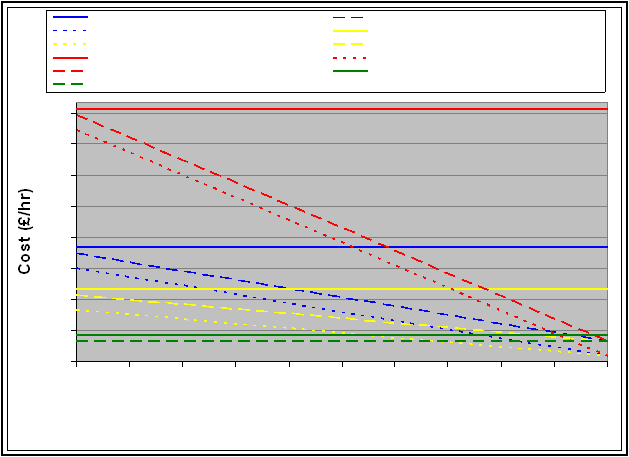
However, in most cases the drivers’ time will have monetary value since they are effectively restricted from
undertaking other activities whilst driving a car. If they are being transported on the ELECAT they can engage
in useful work, detailed communication or enjoy entertainment. This is particularly relevant to the business
driver who isn’t utilised whilst driving. Their comparative costs are plotted as a function of activity ratio,
ranging from 0 where the driver engages in no useful activity to 1 where the full costs of the driver are utilised
in the ELECAT. The comparison is displayed for the drivers using the ELECAT (long dotted lines) and isolated
car drivers (Solid lines). These are separated for private drivers (yellow lines), business drivers (red lines) and
an overall average for all drivers (blue lines).
The greatest benefits of using the ELECAT is for business drivers whose costs are more than halved when fully
utilising the ELECAT, whilst private drivers also experience more modest but still useful cost benefits. Use of
the ELECAT should also generate substantial environmental benefits, although these are not included in these
calculations.
A further advantage of transporting cars on the ELECAT is that it reduces the road space relative to driving
them individually. If the cost of fuel duty can be transferred to road space a further cost saving of about £1.50
per hour per car can be achieved for the ELECAT mode on average, this is illustrated by the short dotted lines.
These calculations assume that ONLY conventional IC engined vehicles are used. However, the main
environmental purpose of the ELECAT is to extend BEVs range and enable their viability as an all round means
of transportation with the goal of largely replacing fossil fuelled cars. The success of the ELECAT as with the
COAST and LOCI concepts would depend on it providing a competitive mode of travel compared with current
travelling methods in terms of journey time, cost and passenger comfort.
9
12
15
18
21
24
27
30
33
0
0.1
0.2
0.3
0.4
0.5
0.6
0.7
0.8
0.9
1
Activity ratio (fraction of time saved by using ELECAT
facilities)
Average Car Driven Individually
Average Car Using ELECAT Fuel Duty based
Average Car Using ELECAT Road Space Based
Private Car Driven Individually
Private Cost Car Using ELECAT Road Space Based
Private Car Using ELECAT Fuel Duty Based
Buisness Car Driven Individually
Business Car Using ELECAT Road Space Based
Business Car Using ELECAT Fuel Duty based
Car Driven individually Zero Driver Cost
Car Driven on ELECAT Zero Driver Cost
Figure 22 Cost of Travelling Using Various Transport modes
Assuming the car driver has no time value, the car (solid green line) has a similar cost to when being
transported on the ELECAT. However assuming the driver can perform activities whilst on the ELECAT and
these have time value, the cost of being transported on the ELECAT is substantially less than when driving an
individual car (Red. Blue and yellow lines)

